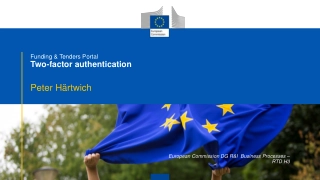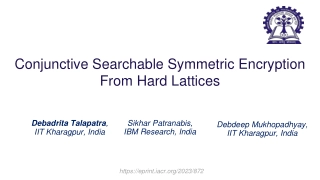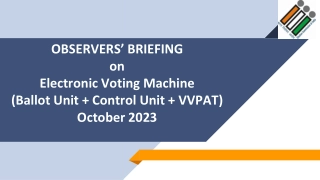Public key encryption, Digital signature and authentication
Understand the concept of public key encryption, asymmetric encryption, and the widely used RSA algorithm. Explore how public key cryptography revolutionized the field of encryption and its applications in confidentiality, authentication, and key distribution.
Download Presentation
Please find below an Image/Link to download the presentation.
The content on the website is provided AS IS for your information and personal use only. It may not be sold, licensed, or shared on other websites without obtaining consent from the author. Download presentation by click this link. If you encounter any issues during the download, it is possible that the publisher has removed the file from their server.
- Public key encryption
- Asymmetric encryption
- RSA algorithm
- Cryptosystems
- Confidentiality
- Authentication
- Key distribution
Presentation Transcript
Public key encryption, Digital signature and authentication
Public-key encryption ( Asymmetric Encryption) Asymmetric encryption is a form of cryptosystem in which encryption and decryption are performed using the different keys one a public key and one a private key. It is also known as public-key encryption. Asymmetric encryption transforms plaintext into ciphertext using a one of two keys and an encryption algorithm. Using the paired key and a decryption algorithm, the plaintext is recovered from the ciphertext. Asymmetric encryption can be used for confidentiality, authentication, or both. The most widely used public-key cryptosystem is RSA. The difficulty of attacking RSA is based on the difficulty of finding the prime factors of a composite number
Public key cryptography.. Contd: The development of public-key cryptography is the greatest and perhaps the only true revolution in the entire history of cryptography. From its earliest beginnings to modern times, virtually all cryptographic systems have been based on the elementary tools of substitution and permutation. Public-key cryptography provides a radical departure from all that has gone before. For one thing, public-key algorithms are based on mathematical functions rather than on substitution and permutation. More important, public-key cryptography is asymmetric, involving the use of two separate keys, in contrast to symmetric encryption, which uses only one key. The use of two keys has profound consequences in the areas of confidentiality, key distribution, and authentication.
Public Public- -Key Cryptosystems Key Cryptosystems Asymmetric algorithms rely on one key for encryption and a different but related key for decryption. These algorithms have the following important characteristic. It is computationally infeasible to determine the decryption key given only knowledge of the cryptographic algorithm and the encryption key. In addition, some algorithms, such as RSA, also exhibit the following characteristic. Either of the two related keys can be used for encryption, with the other used for decryption.
A public public- -key encryption key encryption scheme has six ingredients
Plaintext: This is the readable message or data that is fed into the algorithm as input. Encryption algorithm: The encryption algorithm performs various transformations on the plaintext. Public and private keys: This is a pair of keys that have been selected so that if one is used for encryption, the other is used for decryption. The exact transformations performed by the algorithm depend on the public or private key that is provided as input. Ciphertext: This is the scrambled message produced as output. It depends on the plaintext and the key. For a given message, two different keys will produce two different ciphertexts. Decryption algorithm: This algorithm accepts the ciphertext and the matching key and produces the original plaintext. The essential steps are the following. 1. Each user generates a pair of keys to be used for the encryption and decryption of messages. 2. Each user places one of the two keys in a public register or other accessible file. This is the public key. The companion key is kept private. As Figure: a suggests, each user maintains a collection of public keys obtained from others. 3. If Bob wishes to send a confidential message to Alice, Bob encrypts the message using Alice s public key. 4. When Alice receives the message, she decrypts it using her private key. No other recipient can decrypt the message because only Alice knows Alice s private key. With this approach, all participants have access to public keys, and private keys are generated locally by each participant and therefore need never be distributed. As long as a user s private key remains protected and secret, incoming communication is secure. At any time, a system can change its private key and publish the companion public key to replace its old public key.
some of the important aspects of symmetric and public key encryption. To discriminate between the two, we refer to the key used in symmetric encryption as a secret key. The two keys used for asymmetric encryption are referred to as the public key and the private key. Invariably, the private key is kept secret, but it is referred to as a private key rather than a secret key to avoid confusion with symmetric encryption
RSA Algorithm: by Ron R Rivest, Adi S Shamir, Len A Adelman

















































